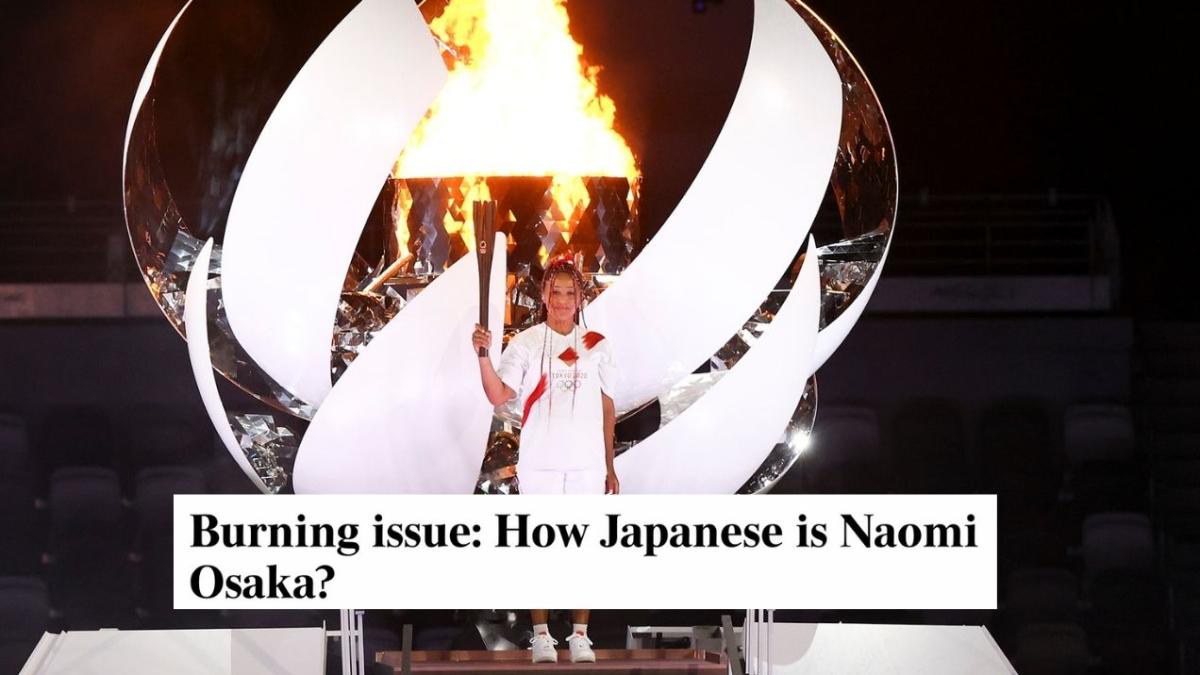
The Australian reckons that Japanese four-time Grand Slam singles champion Naomi Osaka isn’t Japanese enough to light the Olympic torch at the Opening Ceremony of the Tokyo 2020 Olympic Games, and can we yeet these fuckers like shot-put already?
In case you missed it, 23-year-old Japanese-born tennis queen Naomi Osaka took the Olympic stage last night as the final torchbearer of the Tokyo 2020 Summer Olympics. Taking to Instagram shortly after the historic moment, she said it was “undoubtedly the greatest athletic achievement and honour I will ever have in my life.”
“I have no words to describe the feelings I have right now but I do know I am currently filled with gratefulness and thankfulness.”
Last night, The Australian published a yarn by sports reporter Will Swanton, “Burning issue: How Japanese is Naomi Osaka?” In it, Swanton claims that because Naomi Osaka is a “multicultural, multiracial, Japanese-Haitian-American woman with a wonderful mix of bloodlines in her veins,” and left Japan when she was three years old, she isn’t Japanese enough to carry the Olympic torch for the Tokyo 2020 Opening Ceremony. Despite the fact that Japanese baseball legend Sadaharu Oh, who is of both Japanese and Chinese descent, also took part in the final torch run.
And, yes, before you ask, Swanton is white.
“I thought Osaka’s igniting of the flame was the only flat spot of the opening ceremony,” he wrote.
“I thought she looked uncomfortable, which was fair enough – about five billion people were watching someone notoriously shy and introverted.
“Something about it just felt wrong. She hadn’t come from the mean streets of Japanese town to conquer the world. If her life story has a message to any young tennis player, it might be this: get to America, get down to Florida. Osaka flew the coup 20 years ago, and she’s stayed there.”
Swanton added: “At the risk of sounding crude, the truth is that she’s a bit of a blow-in. She flew here, from Florida, to compete. Far better candidates grew here.
“Osaka was born at Chuo-ko, Osaka, in 1997. Her mother, Tamaki, is Japanese. Her father, Leonard, is Haitian. Osaka was three years of age when the family moved to the US to live at Long Island, New York. Osaka has been there ever since. If these were State of Origin eligibility rules, she’d be wearing a US jersey at these Games.”
Here’s the thing: the politics of a white Australian man claiming that a woman of mixed race—and who left her country of origin at a young age–is not enough of one-half of her ethnicity to identify as it, is not great. Making comments like this towards a mixed-race person, in general, is shitty but in a country like Australia, which historically misplaced (and still does) First Nations peoples of mixed origins in an attempt to westernise them, it comes off as tone-deaf.
It’s also particularly tone-deaf when you remember that Australia—and particularly the younger demographic of our population—are mixed race. According to data acquired by the Australian Bureau of Statistics in the 2016 Census, one-third of the Aussie population were not born in Australia. Nearly half of us were either born overseas or had one or two parents who were born overseas.
Speaking with PEDESTRIAN.TV, Japanese-Australian, and former Asahi Shinbun reporter, Miwa Blumer explained that choosing Naomi Osaka to carry the Olympic torch was actually a progressive moment for Japan and marked a shift in the country’s attitude towards mixed race people (‘hafu’).

“Choosing Osaka as the final torchbearer was a progressive choice from Japan. The largely monocultural society has historically struggled to accept difference. Although warming to ‘hafu’ or mixed-race Japanese people in recent years, those from non-caucasian backgrounds are still, in many cases, seen as the ‘other’.
“Swanton speaks of how Yoshinari Sakai [the Olympic torchbearer of the 1964 Tokyo Olympic Games] was the right choice as ‘the symbolism was powerful: Japan was growing up’. Naomi Osaka equally represents the future of Japan. Within the Olympic context, first and foremost – she is an incredible athlete.
“The first Japanese player to ever reach number one in tennis. In recent months, she has also become a symbol of mental health awareness, something which Japan can definitely improve on. Finally, she represents diversity within a society that is increasingly becoming multicultural. Osaka represents everything positive and progressive about what Japan’s future may hold. A society of acceptance. A society that values their successes, their differences and cares about their health.”
Shortly after the article was published, Aussie TV presenter Marc Fennell shared it and explained the impact it has on mixed-race people in Australia.
“On behalf of mixed-race kids everywhere, pls don’t do stuff like this,” he said.
“It’s garbage to be raised in a world where everyone else wants to adjudicate your race.”
On behalf of mixed race kids everywhere, pls don’t do stuff like this. It’s garbage to be raised in a world where everyone else wants to adjudicate ur race. pic.twitter.com/kFFPHydYGl
— Marc Fennell (@MarcFennell) July 24, 2021
“You are continuing to feed a narrative that hurts us and our children every day.” added proud Yankunyjatjara and Wirangu woman, teacher, and presenter, Shelley Ware.
Yes please stop!! You are continuing to feed a narrative that hurts us and our children everyday.
— Shelley Ware (@ShelleyWare) July 24, 2021
In the end, it’s as SBS Voices editor Caitlin Chang said in a reply to Fennell on Twitter: “God, this sucks.”
Will Swanton says “this yarn isn’t a criticism of Osaka,” and he’s right. It’s a lot more than that. Knowing the politics of our nation’s history and its now multicultural identity, this feels like a dig at every mixed-race person in Australia.



